Today’s Current Affairs:15th October 2025 for UPSC IAS exams, State PSC exams, SSC CGL, State SSC, RRB, Railways, Banking Exam & IBPS, etc
Table of Contents
Gomti River:
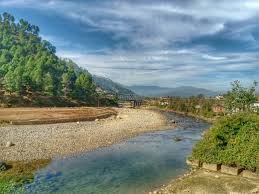
Uttar Pradesh Chief Minister recently launched the ‘Gomti Rejuvenation Mission’ to ensure the uninterrupted flow of the river, setting an ambitious target to intercept 95 percent of urban sewage entering the waterway.
- Gomti River is a tributary of the Ganges (Ganga) River, flowing entirely through the state of Uttar Pradesh.
- The river is also known by the names Gumti or Gomati.
- It originates from the Gomat Taal, otherwise called Fulhaar Jheel, a lake located in the Pilibhit District in Uttar Pradesh.
- The river drains the area between the Ramganga and Sharda Rivers.
- After flowing southwards through the districts of Lucknow, Barabhanki, Sultanpur, Faizabad, and Jaunpur, it joins with the River Ganga.
- The river extends to about 900 km.
- It drains a basin of about 18,750 sq.km.
- The entire Gomti basin is underlain by thick alluvial sediments of the Quaternary age.
- The alluvial sediments consist of boulders, pebbles, gravel, sand, silt, clay, and kankars.
- The unconsolidated unit may be further subdivided into younger alluvium and older alluvium.
- The younger alluvium occupies the present-day flood plains, while the older group occupies elevated portions, mainly the doab portions.
- The older alluvium is characterized by kankar nodules at depth otherwise it is similar to the younger alluvium.
- It is a perennial river. The river is characterised by sluggish flow throughout the year, except during the monsoon season, when heavy rainfall causes a manifold increase in the runoff.
- Significant tributaries of the Gomti include the Sai River, Chowka River, Kathina River, and Saryu River.
- There are various cities that are situated on the banks of River Gomti, such as Sultanpur, Lucknow, Jaunpur, and Lakhimpur Kheri.
- Over the years, Gomti has become one of the most polluted rivers in Uttar Pradesh.
Number Of Births And Deaths In India:

India registered 2.52 crore births in 2023, around 2.32 lakh fewer than in 2022, the Vital Statistics of India based on Civil Registration System (CRS) report for the year 2023 shows.
- India registered 52 crore births in 2023, around 2.32 lakh fewer than in 2022, according to the Vital Statistics of India based on the Civil Registration System (CRS) report for the year 2023.
- The report, compiled by the Registrar General of India (RGI), stated that 86.6 lakh deaths were registered in 2023, a marginal increase from 86.5 lakh deaths in 2022.
- There was no major spike in deaths in 2022 and 2023, despite the COVID-19 dashboard maintained by the Health Ministry showing that the total number of pandemic-induced deaths stood at 533,665 as on May 5, 2025.
- However, there was a significant rise in deaths in 2021, the second year of COVID-19 lockdown, which recorded an excess of 21 lakh deaths from the 2020 count.
- There were 81.2 lakh deaths in 2020 and 102.2 lakh in 2021.
- Jharkhand recorded the lowest sex ratio at birth at 899, followed by Bihar at 900, Telangana at 906, Maharashtra at 909, Gujarat at 910, Haryana at 911, and Mizoram at 911.
- The highest sex ratio was reported by Arunachal Pradesh at 1,085, followed by Nagaland at 1,007, Goa at 973, Ladakh and Tripura at 972, and Kerala at 967.
- The share of institutional births in total registered births is % in 2023. However, the report did not include information from Sikkim.
- Overall registration of births for the year 2023 stood at 98.4%.
- 11 States/Union Territories (UTs) achieved more than 90% registration of births within the prescribed time limit of 21 days.
- These States are Gujarat, Puducherry, Chandigarh, Dadra and Nagar Haveli and Daman & Diu, Tamil Nadu, Lakshadweep, Andaman and Nicobar Islands, Haryana, Himachal Pradesh, Goa, and Punjab.
- Five States — Odisha, Mizoram, Maharashtra, Chhattisgarh, and Andhra Pradesh — reported 80-90% registration.
- In 14 States — Assam, Delhi, Madhya Pradesh, Tripura, Telangana, Kerala, Karnataka, Bihar, Rajasthan, Jammu & Kashmir, Jharkhand, West Bengal, Meghalaya, and Uttar Pradesh, the registration stood at 50-80%.
Integrated Alert System (SACHET):

In a session on disaster risk reduction (DRR) at the ongoing G20 ministerial meeting in Durban, India’s Principal Secretary to the Prime Minister outlined India’s multi-agency architecture integrating meteorological, hydrological, seismic, and oceanographic institutions through a Common Alert Protocol–compliant Integrated Alert System.
- Integrated Alert System (SACHET) is a disaster early warning platform envisioned by the National Disaster Management Authority (NDMA) to provide real-time geo-targeted alerts to citizens.
- It was developed by the Centre for Development of Telematics (C-DOT), the premier R&D center of the Department of Telecom.
- It is based on the Common Alerting Protocol (CAP) recommended by the International Telecommunication Union (ITU).
- It integrates multiple stakeholders to bridge communication gaps and employs multiple technologies, including SMS, Cell Broadcast, Mobile App, TV, Radio, Social Media, RSS Feed, Browser Notification, and Satellite, for enabling effective communication and ensuring last-mile reachability.
- This system is already operational in all States and Union Territories (UTs) of India and sends various disaster- or emergency- related alerts through SMS to mobiles of citizens affected in a particular geo-targeted area.
- Users can receive alerts for their current location or subscribe to any state/district in India to receive alert notifications.
- The SACHET mobile app provides warnings from authorized Government sources and authorities to warn the public of a possible disaster situation.
- The app provides weather reports and forecasts from the Indian Meteorological Department (IMD) for day-to-day weather updates.
Campi Flegrei Volcano:
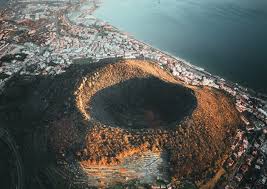
An Artificial Intelligence (AI) model has revealed never-before-seen geological structures at Italy’s Campi Flegrei volcano, including a clear “ring fault” that could unleash magnitude 5 earthquakes.
- Campi Flegrei, also known as the Phlegraean Fields, is an active volcanic region situated in the densely populated Bay of Naples in Italy, which is also home to the more famous Vesuvius Volcano.
- It differs from traditional volcanoes like Mount Vesuvius, as it is not a single volcano but a volcanic system spread across a large caldera.
- It is the largest active volcanic caldera in Europe, far larger and more active than Mount Vesuvius.
- The caldera, or volcanic depression, spans approximately 12–15 km in diameter and was created due to a massive eruption around 39,000 years ago.
- This eruption is hypothesized to have had such a climatic impact that it contributed to the decline of Neanderthals.
- One-third of Campi Flegrei lies beneath the Tyrrhenian Sea, between the Italian mainland and the island of Sardinia.
- The last recorded eruption was in 1538, forming Monte Nuovo and ending an interval of roughly 3000 years without eruptions.
- Campi Flegrei is categorised as a supervolcano, implying that a large-scale eruption could have global consequences, including climate disruption.
- The volcano has been showing signs of unrest since 2005.
- It is characterised by intense hydrothermal activity, episodes of localised ground deformation, and earthquake swarms.
Steadfast Noon:
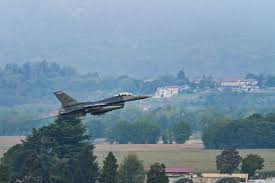
NATO’s annual nuclear deterrence exercise, Steadfast Noon, will be hosted by the Netherlands this year.
- Steadfast Noon is an annual nuclear exercise by NATO (North Atlantic Treaty Organization).
- It is an important test for the alliance’s nuclear deterrent.
- It is hosted by a different NATO country each year.
- The 2025 edition of the exercise is being hosted by the Netherlands, with Volkel Air Base serving as the main operating site.
- Bases at Kleine Brogel in Belgium, Lakenheath in Britain, and Skrydstrup in Denmark will also be involved.
- Those nations, as well as Finland, Poland, the United States, and Germany, are among the participants.
- It will involve around 70 aircraft from 14 allied nations, including both conventional and dual-capable aircraft.
- Dual-capable aircraft refers to aircraft that can deliver both conventional and nuclear weapons, which includes Germany’s Tornado, as well as the American and Dutch F-35 jets.
- The exercise won’t use any actual nuclear weapons.
- Pilots and aircraft involved in the exercise are certified for the nuclear mission, but no weapons are loaded or flown.
- France isn’t participating in the exercise, as the country keeps its nuclear forces separate from NATO’s command-and-control structure and decision-making process.
Indian wolf : Recent Study
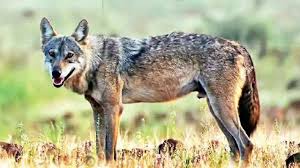
The International Union for Conservation of Nature (IUCN) has for the first time evaluated the Indian wolf (Canis lupus pallipes) separately.
- It is a subspecies of the Grey Wolf found in the Indian subcontinent and Southwest Asia.
- It prefers scrublands, semi-arid grasslands, and pastoral agro-ecosystems.
- Indian wolves generally live in smaller packs rarely exceeding 6-8 individuals.
- They are also relatively less vocal and have rarely been known to howl and are territorial and hunt during the night.
- Intermediate in size between the Tibetan and Arabian wolves, but lacks a thick winter coat due to adaptation to warmer climates.
- Indian wolves are found in India, Pakistan, Afghanistan, Nepal, Bhutan, Israel, Turkey, Iran, and Syria.
- Threats: It faces a steady decline driven by habitat loss, shrinking prey base, and human persecution.
- Conservation Status
- IUCN: Vulnerable
- CITES: Appendix I
- Wildlife (Protection) Act, 1972: Schedule I.
LEAPS 2025:
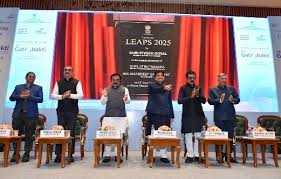
The Union Minister for Commerce and Industry launched the Logistics Excellence, Advancement, and Performance Shield (LEAPS) 2025 in New Delhi.
- LEAPS is a flagship initiative of the Department for Promotion of Industry and Internal Trade (DPIIT) under the Ministry of Commerce and Industry,
- It aims to benchmark logistics excellence, strengthen India’s competitiveness, and align with the vision of the National Logistics Policy (NLP) and PM GatiShakti.
- LEAPS 2025 has been conceptualized to acknowledge and celebrate best practices, innovation, and leadership within India’s logistics industry.
- It covers a wide spectrum of logistics players, including air, road, sea, and rail freight operators; warehousing; multimodal transporters; MSMEs; Startups; and Academia.
- The initiative also emphasizes sustainability, ESG (Environmental, Social, and Governance) practices, and Green Logistics, encouraging collaboration between Government, Industry, and Academia to enhance efficiency, transparency, and resilience in the logistics ecosystem.
- PM Gati Shakti aims to understand current gaps in logistics connectivity and facilitate the development of logistics infrastructure (creating connectivity between roadways, rail transport, waterways, and air transport) so as to reduce logistics costs.The programme has an estimated cost of ₹100 trillion.
Blue Flag Certification : Five Beaches In Maharashtra Received
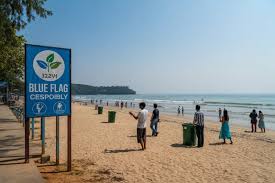
Five beaches in Maharashtra have received the international Blue Flag certification.
- Blue Flag Certification is a globally recognized eco-label accorded by the Foundation for Environment Education in Denmark (FEE).
- It is awarded to beaches that meet 33 criteria related to cleanliness, beauty, and environmental sustainability.
- The Blue Flag programme was started in France in 1985 and in areas outside of Europe in 2001.
- It is one of the world’s most recognised voluntary awards for beaches, marinas, and sustainable tourism boats.
- It promotes sustainable development in freshwater and marine areas through four main criteria: water quality, environmental management, environmental education and safety.
- The mission of Blue Flag is to promote sustainability in the tourism sector, through environmental education, environmental protection and other sustainable development practices.
- The other Indian beaches in the blue list are Shivrajpur-Gujarat, Ghoghla-Diu, Kasarkod and Padubidri-Karnataka, Kappad-Kerala, Rushikonda- Andhra Pradesh, Golden-Odisha, Radhanagar- Andaman and Nicobar, Kovalam in Tamil Nadu and Eden in Puducherry beaches, Minicoy Thundi Beach, Lakshadweep, Kadmat Beach.
National ‘Red List’ Assessment Initiative:

India launched the five-year National Red List Assessment Initiative (2025-2030) to evaluate the conservation status of its flora and fauna, announced at the IUCN World Conservation Congress in Abu Dhabi.
- National ‘Red List’ Assessment Initiative aims to systematically identify and protect India’s most vulnerable species, in line with global environmental commitments, and IUCN standards.
- It will evaluate the extinction risk of approximately 11,000 species—including 7,000 flora and 4,000 fauna—to develop a National Red List.
- It will be spearheaded by the Union Ministry of Environment, Forest and Climate Change, with key implementing bodies including the Botanical Survey of India (BSI), Zoological Survey of India (ZSI), and the Wildlife Institute of India (WII).
- It will fulfill Target 4 of the Kunming-Montreal Global Biodiversity Framework (KM-GBF), which calls for halting species extinction, protecting genetic diversity, and managing human-wildlife conflicts.
- As a signatory to the Convention of Biological Diversity (CBD), India is obligated to monitor and conserve its biodiversity, and this assessment provides the essential scientific basis for that effort.
- Of the assessed fauna, 13.4% are threatened, 289 species are near threatened, and 13.8% are data deficient, with their conservation status unknown.
- India exhibits high endemism, with 79% of amphibians and 54.9% of reptiles found nowhere else in the wild.
Sharm el-Sheikh:
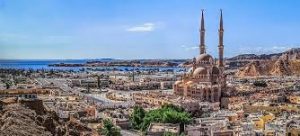
World leaders have convened at Sharm el-Sheikh, Egypt, for the ‘Summit for Peace’, led by U.S. President Donald Trump. The meeting aims to end the two-year-long Gaza conflict and to restore stability in the Middle East.
- Sharm el-Shaikh is located at the southern tip of the Sinai Peninsula, overlooking the Strait of Tiran at the mouth of the Gulf of Aqaba, along the Red Sea.
- The Strait of Tiran, connecting the Red Sea and the Gulf of Aqaba, is a vital maritime route and Israel’s sole access to the Indian Ocean.
- Originally a fishing village, the town became a strategic naval base for the Egyptian Navy and later a major international diplomatic venue.
- Israel occupied Sharm el-Sheikh during the Six-Day War in 1967 and returned it to Egypt in 1982 following the Camp David Accords.
- Egyptian President Hosni Mubarak designated it as the “City of Peace” in 1982, promoting international investment and tourism.
- Sharm el-Sheikh has become a major diplomatic hub, hosting landmark peace talks and global summits central to Middle Eastern diplomacy.
India’s Blue Economy : NITI Aayog Report
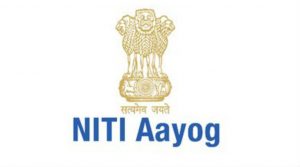
NITI Aayog released a report “India’s Blue Economy – Strategy for Harnessing Deep-Sea and Offshore Fisheries” outlining a scientific, sustainable, and inclusive roadmap for developing India’s deep-sea and offshore fisheries.
Current Status:
- India’s deep-sea fishing remains nascent, despite an estimated 7.16 million tonnes (MT) potential within its EEZ.
- Only 4 Indian-flagged vessels operate in high seas versus Sri Lanka’s 1,883 and Iran’s 1,216, reflecting weak international engagement.
- No specific law governs fishing between 12–200 nautical miles, leading to IUU fishing and legal ambiguity.
- States regulate only up to 12 nmi, restricting oversight of larger marine zones.
Mission Drishti : The World’s First Multi-Sensor Earth Observation (EO) Satellite

Indian space-tech startup GalaxEye has announced the launch of ‘Mission Drishti,’ the world’s first multi-sensor Earth Observation (EO) satellite, scheduled for the first quarter of 2026.
- Mission Drishti is the world’s first satellite integrating multiple sensing technologies—Synthetic Aperture Radar (SAR) and Optical sensors—on a single platform, enabling real-time, all-weather Earth observation.
- Developed by GalaxEye Space, a Bengaluru-based private space startup founded by alumni of IIT Madras.
- Aim is to provide high-resolution, multi-source geospatial intelligence for applications in defense, disaster management, infrastructure, utilities, agriculture, and financial risk assessment, strengthening India’s data-driven governance and security capabilities.
- Key Features:
- World’s first multi-sensor integration: Combines SAR and optical imaging, ensuring 24×7, all-weather monitoring.
- High-resolution imaging: Offers 1.5-meter resolution, among the highest in its category.
- Largest private satellite: Weighs 160 kg, India’s largest privately-built satellite to date.
- AI-driven analytics: Enables advanced data fusion and geospatial insights for precision planning.
- Constellation plan: 8–10 satellites to be launched over four years, forming an integrated global observation network.
National Household Income Survey (NHIS) 2026:
The Ministry of Statistics & Programme Implementation (MoSPI) plans to launch the National Household Income Survey (NHIS) in February 2026.NHIS 2026 will be the first-ever pan-India household income survey. This survey will enable inter-personal income comparisons and detailed analysis of income sources, addressing a long-standing data gap in India’s socio-economic statistics.NHIS 2026 aims to capture living conditions, income and expenditure patterns, and provide critical data for rebasing the Consumer Price Index (CPI), preparing National Accounts, and conducting poverty and hardship analysis.The National Statistics Office (NSO) under MoSPI has conducted large-scale household surveys since 1950.The National Sample Survey (NSS) provides key official statistics on household welfare, consumption, employment, health, assets, and indebtedness, supporting evidence-based policymaking. Countries like the US, Canada, UK, Sri Lanka, Bangladesh, China, and Malaysia already collect household income data through surveys. The NHIS will bring India in line with these international best practices.
Alliance Air’s “Fare Se Fursat” Fixed Airfare Scheme:

Union Civil Aviation Minister launched Alliance Air’s “Fare Se Fursat” Fixed Airfare Scheme, giving passengers freedom from fluctuating airfares and promoting affordable, predictable air travel under the UDAN vision.
- It is a first-of-its-kind initiative by Alliance Air that introduces a single, fixed airfare which remains constant irrespective of booking dates, including last-minute travel.
- Airline Involved: Implemented by Alliance Air, a government-owned regional carrier.
- Aim is to democratize aviation by making air travel affordable, transparent, and stress-free for middle-class and first-time flyers.
- Key Features:
- Fixed pricing: One fare for each route—unchanged even on the day of travel.
- Pilot phase: Operational from October 13 to December 31, 2025, across select UDAN routes.
- Passenger-friendly approach: Eliminates uncertainty caused by dynamic ticket pricing.
- Focus on inclusion: Encourages flyers from smaller towns and Tier-2/3 cities to use air transport.
- Aligned with UDAN: Promotes “Naye Bharat ki Udaan” — aviation as a public service, not merely profit-driven.
Alliance Air:
- Alliance Air is a government-owned regional airline operating under Air India Asset Holdings Limited (AIAHL), serving as the backbone of India’s Regional Connectivity Scheme (UDAN).
- Established in: April 1996, originally as a subsidiary of Indian Airlines, and later continued as a separate state-owned carrier after Air India’s privatization in 2021.
Armenia has become the newest State Member of the International Union for Conservation of Nature:
Armenia is a landlocked country, located in the south of Caucasus mountain range.It is bounded by Georgia in the north, Azerbaijan in the east, Iran in the southeast and Turkey in the west.The Lesser (or Little) Caucasus Mountains dominate much of Armenia’s landscape.Much of Armenia’s soil—formed partly by residues of volcanic lava—is rich in nitrogen, potash, and phosphates. Highest Peak: Mount Aragats (4,090 m) which is an extinct volcanic peak. Climate: Highland continental, hot summers, cold winter climate. Rivers: Aras, Hrazdan, Arpa, and Vorotan, rivers which provide hydropower and irrigation facility to country. Small deposits of gold, copper, molybdenum, zinc, bauxiteLakes: Lake Sevan is the largest lake of Armenia.The official and national language of Armenia is Armenian, spoken by the vast majority of the country’s population. Capital: Yerevan.
Maldives as the first country in the world to achieve triple elimination:
The World Health Organization (WHO) has validated the Maldives as the first country in the world to achieve “triple elimination” stopping mother-to-child transmission of HIV, syphilis, and hepatitis B, marking a historic global public health milestone.Triple Elimination refers to a country successfully preventing mother-to-child transmission (EMTCT) of HIV, syphilis, and hepatitis B — three major infectious diseases affecting newborns globally.
WHO validates countries only when zero new infant cases are reported for at least two consecutive years, with strong monitoring systems and universal maternal healthcare.




